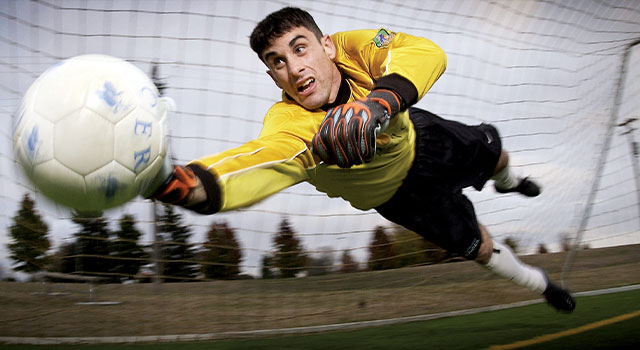 Sports require athletes to be in peak physical condition to play at their best. This doesn’t just include arms and legs, but eyes too. This is especially true for goalkeepers, who need lightning-fast reflexes and incredibly accurate vision skills to guard the goal and catch or deflect the puck or ball and prevent that scoring shot.
Sports require athletes to be in peak physical condition to play at their best. This doesn’t just include arms and legs, but eyes too. This is especially true for goalkeepers, who need lightning-fast reflexes and incredibly accurate vision skills to guard the goal and catch or deflect the puck or ball and prevent that scoring shot.
Our eye care professionals at Sports Vision Center at EYEcenter Optometric can help goalies and other athletes, both amateur and pro, improve their functional vision with sports vision training.
What Visual Skills Does a Goalkeeper Need?
Goalies need to master a range of visual skills in order to prevent the opposing team from scoring. Convergence and divergence, as well as the ability to alternate between them quickly and accurately, are among the most important.
Convergence
Convergence is the eyes’ ability to efficiently and accurately focus on an object as it moves toward you, and up close. Professional soccer players send the ball flying at the net at an average of 70 miles per hour, and a hockey puck in the NHL can be slapped at the goal at a blistering 100 miles per hour. This means that for penalty shots and other fast-moving, close-up plays a goalkeeper’s eyes can have mere fractions of a second to accurately converge on the ball or puck before the goalkeeper needs to decide where to move their body and how to react.
Poor convergence can mean that the goalie’s eyes are too slow to converge on the target, or that they don’t converge accurately, leading to double vision as the ball or puck is incoming.
Either of these situations can make it difficult, if not impossible, to make the save during a fast-paced play.
Divergence
Divergence is the eyes’ ability to efficiently and accurately focus on objects at a distance, and as they move away. This skill is vital for goalkeepers, who need to save shots taken from halfway down the field or ice, and to accurately judge the position and flight of the ball or puck. Divergence also allows the goalkeeper to track shots that rebound out, as well as the movements of the puck or ball in case the opposing team quickly takes another shot.
Poor divergence makes it challenging for the goalie to find or track the target from farther out, or as it moves away from them, from close range into the distance.
Alternating
Being able to efficiently alternate between convergence and divergence is also vital in a fast-moving game. Consider the following play-by-play:
- Using divergence, a goalkeeper can track a ball or puck from far down the field or ice, until a shot is taken.
- As the shot comes closer in, they engage their convergence to track it moving toward them.
- They make a successful save, resulting in a rebound out. Divergence is engaged as the ball or puck moves away from them once again.
- Within fractions of a second, an opposing player may recover the puck or ball, and attempt another shot. The shot is incoming again, and convergence is re-engaged.
The goalkeeper has only seconds or even fractions of a second to respond, re-focus, and respond again.
How Can Sports Vision Training Help?
Sports vision training is a personalized regimen of eye exercises prescribed by eye doctors to help athletes perfect the visual skills that are most essential for their sport.
Working through the prescribed exercises retrains the athlete’s brain to work faster and more effectively with their eyes, improving convergence, divergence and other visual-motor and spatial skills.
Sports vision training can help goalkeepers of all ages and abilities gain the visual skills they need to stay on top of their game, block shots and save the day.
Have questions about how we can help you play your best game? Visit us or call our office today.
Our practice serves patients from Citrus Heights, Rocklin, Folsom, and Sacramento, California and surrounding communities.
